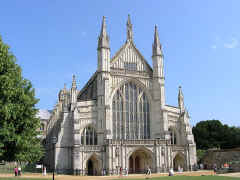Winchester Cathedral Architecture 85 photos with architectural notes This page for the exterior, or go direct
to the interior |
||||
|
Information mainly from Hampshire and the Isle of Wight by Nikolaus Pevsner and David Lloyd (1967) Yale University Press, New Haven and London. Direct quotes in italics. |
||||
|
Winchester Cathedral is an excellent representation of all the architectural styles through the Middle Ages, i.e from Romanesque (Norman) through the three main phases of Gothic: Early English, Decorated and Perpendicular. |
||||
|
|
||||
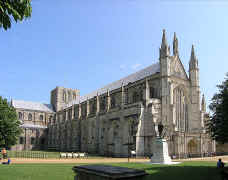
|
||||
|
|
||||
|
General view from the north-west. The cathedral is the longest in Europe, 556 feet. Built largely of stone from the Isle of Wight. Originally all Norman, started in the 1070s, there are several major periods of re-building in later styles up to the early 1500s. This picture shows the Norman tower and north transept begun 1079 and the nave remodelled in Perpendicular Gothic in the late 1300s. |
||||
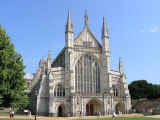 
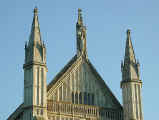
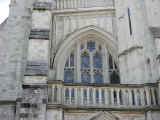
|
||||
|
The west end is a particularly good specimen of
Perpendicular architecture, i.e. a grid of vertical panelling in both
windows and walls. It is in three sections, fronting the nave and two
aisles.
The central nave section is flanked by two slender octagonal towers. |
||||
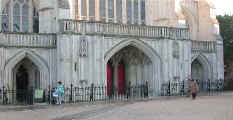
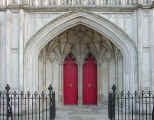
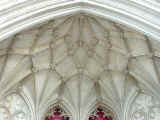
|
||||
|
The three entrance porches at ground level have panelled sides and lierne vaults. The central arch is four-centred, the aisle arches become straight after the initial curve. Top balustrade. |
||||
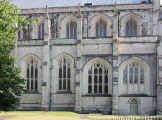
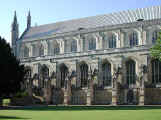
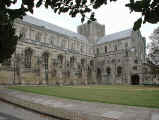
|
||||
|
Nave, north side. The
first two windows from the west at aisle level are broader than the rest, being four-light windows with four-centred
arches. They were built first and then the nave design changed. |
||||
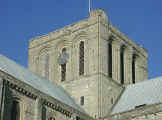
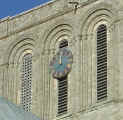
|
||||
|
The Crossing Tower has small Norman windows below and three tall Norman arches above on each side of the tower. The tower windows carry zigzag carving on shafts and rolls, indicating a date a little after 1100 - in fact, a rebuilding after the original tower had fallen in 1107. |
||||
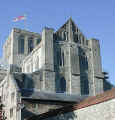
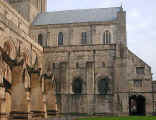

|
||||
|
South transept, south
face. Norman window openings, but two of them with Perpendicular tracery
inserts. Two buttresses with flat turrets, another buttress up the
middle. In the gable is blank, flat intersecting arcading, and higher up
stepped arches. |
||||
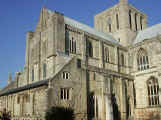
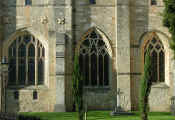
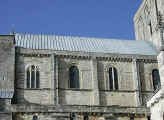
|
||||
|
South transept,
east face. Similar to west face except for ground level
windows, see next picture. |
||||
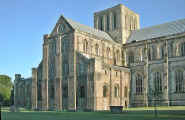
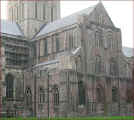 |
||||
|
North transept. Largely similar to south transept but with some variations in the detail. |
||||
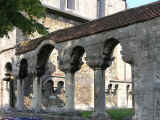
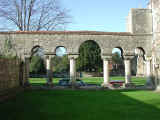
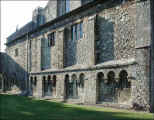 |
||||
|
Chapter House remains on south side of south transept. Pevsner describes the entrance as one of the mightiest pieces of Early Norman architecture in the land. Entrance and two bays of arcading l., two r. Sturdy round piers and big capitals of two scallops. Inside blank arcading all along the N side. Block capitals. |
||||
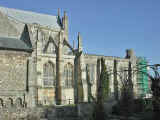
|
||||
|
Cathedral east of transept. Three sections of different periods: Chancel, Retrochoir, Lady Chapel (under scaffold, but uncovered below). |
||||
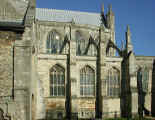 
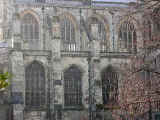 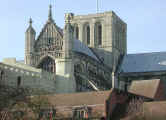 |
||||
|
The Chancel (also
called presbytery) is Perpendicular and largely of early 1500s, although
the arcades inside are of early 1300s. The
east bay cants in noticeably where the earlier Norman ambulatory curved
round. Four-light windows with panelled tracery.
Flying buttresses. Plain parapet. |
||||
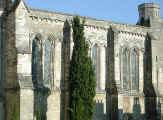 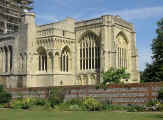
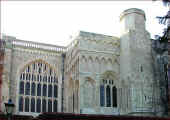 
|
||||
|
Retrochoir, south side, Early
English c.1200. Pevsner: The exterior of the N and S sides of the retrochoir is of noble
design. Three bays, with a high bare ground stage and above tall blank
arcading, four units per bay with the middle ones a pair of lancet
windows (i.e. tall, narrow with pointed arches, typical of Early
English style). |
||||
| To Interior | ||||
|
Jane Austen - grave and memorials in the cathedral King Canute and Queen Emma - mortuary chest and information Ecclesia - medieval statue in cathedral Winchester Cathedral's Website Robert Willis, The Architectural History of Winchester Cathedral 1846 - Very comprehensive |
||||
 |
||||
| Other Winchester Buildings | ||||
